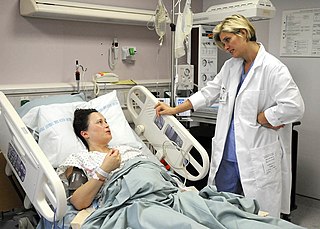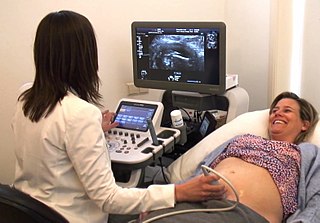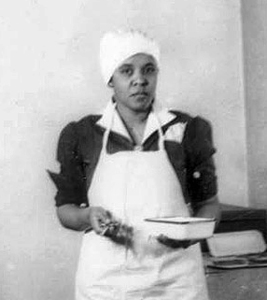History
Granny midwife is a name used to refer to traditional African American midwives in the (typically rural) South. [10] [11] [12] Though the term was used by federal and state governments derogatorily to suggest ignorance, it was also used by the midwives themselves and reclaimed from its derogatory connotation to instead connote the wisdom of age of the granny. [10] [11] Granny midwives were historically lay midwives, but many granny midwives who practice today combine nurse-midwife training with traditional granny midwifery methods. [10]
According to scholar Sharon Robinson, the first black lay midwife arrived in what is now America in 1619. [10] She came from Africa as an enslaved woman and served her community as a midwife and as a physical and spiritual healer. [10] During the reign of slavery in the United States, nearly every large Southern plantation, particularly in South Carolina, had at least one knowledgeable midwife-healer. [12] There is evidence that some freedwomen served as midwives on the plantations of their former masters for no charge to the plantation. [12] In some cases, plantation masters even rented out their enslaved grannies to neighboring plantations for additional income. [12]
Black midwives were not only common in slave communities, they were also revered as elder healers. [10] [12] [13] Their spiritual and medicinal knowledge gained them special social status in their communities. [12] [14] An important component of granny midwifery was this spiritual knowledge and authority; granny midwives considered themselves to have been spiritually called to the work of healing and midwifery. [12] [13] In South Carolina, Angolan and Kongo constructions of ancestral spirits were important tenets of religion, and granny midwives had unique understandings of the workings of such spirits as they were keepers of spiritual knowledge. [12]
Black lay midwives, or granny midwives, continued providing essential healthcare services to their communities after the abolition of slavery and into the 19th, 20th, and 21st centuries. [10] [12] At the start of the 20th century, specifically between 1900 and 1940, the professionalization of obstetrics and gynecology lead to a campaign against all lay midwives by the United States government, but especially the racialized figure of the granny midwife in the American south. [10] [12] Increased regulatory legislation of lay midwives at the state level between 1900 and 1930 was a key facet of the campaign against granny midwives. [10] [12]
In 1921, the Sheppard-Towner Maternity and Infancy Protection Act afforded federal funds for midwifery training programs to state health departments. [11] [15] States used this money to create training and regulatory programs for lay midwives. [11] By the year 1933, most states passed mandatory birth registration and certificate laws. [12] [15] [16] These laws complicated the work of granny midwives significantly, particularly because they lived in rural settings where illiteracy was common and access to registration filing facilities was more limited than in urban areas. [12] [15] [16] In her dissertation tracing the history of African-American midwifery, scholar Kelena Reid Maxwell examined portrayals of African-American midwives in historical medical journals, the profiles of granny midwives serving in the 30s and 40s in the American South, and many other primary historical documents. She notes that both the training and regulatory programs and mandatory registration and certificate laws jointly contributed to the diminishing number of midwives in places like Macon County, Alabama. [17] In her words, “Macon County, Alabama ran a well-documented campaign against African-American midwives,” and tried to forbid midwives who could not or would not work with the state from practicing altogether. [17]
Another facet of the campaign against midwives and towards greater professionalization and exclusivity in obstetrics was the development and expense of medical technology. [10] Traditional midwifery techniques were constructed as inferior to newly marketed obstetric technology, such as forceps. [10] The United States government developed pamphlets and posters to spread this message, among others, to the American population. [10] Included in such publications was information equating black midwifery with “witchcraft” and “witch doctors” of West Africa, as well as with uncleanliness and ignorance. [10] [12] [17]
State and federal campaigns against lay midwives had deleterious effects on the numbers of practicing midwives in the American South. [10] In her book, Granny Midwives and Black Women Writers: Double-Dutched Readings, scholar Valerie Lee notes that a federal survey of lay midwives in the 1920s found 42,627 predominantly black midwives were practicing in the United States and serving predominantly black communities. [10] These percentages declined somewhat over the next twenty years, though more than 60 percent of black women giving birth in the South in 1937 were still attended by granny midwives, while only 10 percent of white babies births were attended by individuals other than physicians. [10] [17] By 1940, 22 percent of black women were giving birth in hospitals, compared to 56 percent of white women. [17] These numbers would drop dramatically over the next six decades, with granny midwives coming to make up a small minority of birth attendants by the 21st century. [10]
In Listen to me Good, the autobiography of Alabama granny midwife Margaret Charles Smith, as recorded by Linda Janet Holmes, Smith relates her life story as a granny midwife in Alabama in the late twentieth century. Mrs. Smith was licensed to practice midwifery by the state in the late 1940s, after Alabama began to regulate lay midwives. [18] At the time, becoming a registered midwife in Smith's home of Greene County, Alabama required either a state-run month-long lay midwifery training course or a nurse-midwifery education that could take several years. [18] In addition to formally recognized training, granny midwives seeking to be registered had to be recommended and supported by two physicians and demonstrate cleanliness and Christian morals. [18] Mrs. Smith attended her last birth in 1980. [18] Mrs. Smith is an example of a granny midwife who practiced in some capacity up until the end of the last century. [18]
There are several organizations in existence to day that are dedicated to preserving traditional Black midwifery knowledge and increasing the number of Black midwives and healers. Examples of such organizations include the International Center for Traditional Childbearing, located in Portland, Oregon, and Birth in the Tradition: Traditional Midwifery, Monitrice, and Doula Services in the state of Georgia. [19] [20]
Training
Before the professionalization of obstetrics and the United States government campaign to train granny midwives, granny midwives were traditionally trained through apprenticeship after being spiritually called to the profession. It was not uncommon for the calling to midwifery to be passed matrilineally from generation to generation or through some other family tradition. In such cases of apprenticeship, the midwife-in-training might serve as apprentice until her mentor retired, though this was not always the case. [10] [12] [13] [14]
State-sponsored training and regulation of midwives took many different forms and existed to varying degrees in numerous states from the 1900s onwards. In Maryland in 1910, there were 23,456 lay midwives, who had in many cases had been practicing for decades, required to be recognized by the state in order to practice. [12] They had to be able to read and write, to attend at least five confinements under supervision, and to demonstrate to the state board of health that they could attend to normal labor. [12] The state also had regulatory measures which required doctors to check in after every midwife-assisted birth so that they could identify and report any infractions made by the midwives. [12]
Eight years later in 1918, Alabama passed a law requiring all midwives currently practicing in the state to register with the state board of health and to pass an elementary examination. [17] In response to this new law, the John A. Andrew Hospital of Tuskegee University organized a training program for midwives in Macon County. [17] The program aimed to prepare Macon County midwives for the examination and to equip them with some basic formalized medical training. [17] The course was four weeks in length and the midwives were given lectures by hospital staff and assigned to observe birth in the hospital setting. [17] Other lessons included bed making, food preparation, and cutting the umbilical cord. [17] Mississippi began a similar program of training and regulation after the 1921 passage of the Sheppard-Towner Maternity and Infancy Protection Act, which provided federal funds for such midwifery training programs. [11] [13] Mississippi's training and regulation program focused on community based large meetings or “clubs” where midwives gathered for instruction by public health nurses. A “lead” or “president” midwife would instruct the group in the case of a nurse absence. These club meetings function as a way of initially training the midwives and then sustaining training and development, as well as places of support. [11] [13]
Procedures
Granny midwives use a variety of healing techniques and practices. Historically, granny midwives used both herbal and spiritual remedies. Some granny midwives used the phases of the moon to time pregnancies. [16]
Archeologist Laurie A. Wilkie compared the oral histories of granny midwifery tradition with an archeological record in her article "Expelling frogs and binding babies: conception, gestation and birth in nineteenth-century African American midwifery". Wilkie reports that granny midwives had specific procedures for every stage of the maternal process, from pregnancy to delivery to post partum and oral histories of their traditions are confirmed by archeological artifacts from the nineteenth century. [10] [21] When a woman in a community was pregnant, a granny midwife might have gone and stayed with that woman and her family for weeks or days leading up to her predicted due date. [10] [16] The granny midwife might have helped with the pregnant woman's household chores in addition to caring for the pregnant woman. [10] [16] To prepare for delivery, the granny midwife might have applied lard or Vaseline to an expecting woman's perineum to lessen the likelihood of tearing and ease the passage of the infant. [21]
In her survey of nineteenth century granny midwifery practices, scholar Laura Wilkie describes a ritual performed by granny midwives and expecting families during labor known as “fussing”. [21] According to Wilkie, fussing occurred during the second stage of labor and involved the midwife and the expecting woman's family and friends entering the birth room and adorning the expecting woman's body and hair with fragrant oils. [21] Fussing involved massaging and encouragement. [21] The fragrances served to relax and encourage the mother in her labor while also warding off bad spirits and binding the coming infant's spirit to the physical world. [21] Binding an infant's spirit to people and things in the physical world was believed to keep the spiritual world from reclaiming the infant's spirit. [21]
Granny midwives had specific protocols for newborn infants. When children were born, granny midwives might place charms on the infant such as silver or copper coins to help bind the infant's spirit to its body. [21] Granny midwives also encouraged breastfeeding after birth, as breast milk would pass the mother's wisdom or “mother wit” to her infant. [21] Breast milk served as an additional spiritual binder for the infant, binding its spirit to the mother's. [21] Another common practice among granny midwives was the coating of infant's skin in lard, tallow, or Vaseline. [21] This not only protected the infant's skin from the elements, but it also prevented meconium from adhering to the infant's skin. [21]
Granny midwives used a range of herbal and other remedies. Emmenagogues, used to stimulate menstrual bleeding and as abortifacients, such as tansy, pennyroyal, senna, cottonseed, cedar berries, juniper, ginger, turpentine, asafetida, and camphor were known to and used by granny midwives. [21] Granny midwives were also known to carry castor oil, black pepper tea, goose grease, and other remedies to stimulate labor and aid in contractions. [10] [21]
After the United States began licensing granny midwives, strict rules where put into place about what granny midwives should carry to treat their patients. [10] Scholar Valerie Lee writes that in Florida, midwives registered with the state were mandated to carry such things as baby scales, safety razors, and silver nitrile solution. [10] However, the midwives supplemented these mandates with their own trusted remedies and tools, such as nail files, aspirin, camphor, Vaseline, and collapsible birthing stools. [10]







